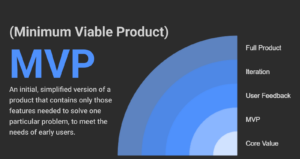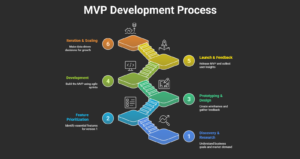Introduction
With the pace of digital technology being much faster than ever, businesses can’t play at the toss-up with candidates who are not validated. As development costs increase and competition grows, going into building a full product without validation is a bad bet. That’s where MVP development enters the scene – a practical, strategic approach to innovation with a lower-risk approach and higher chances of success. Collaborating with a well-equipped MVP development company enables companies to plug assumptions, prove product-market fit, and get genuine user feedback – all before a massive investment.
Unlike typical development, which normally needs lengthy timelines and large spending, MVP is centered on finding out quickly and enhancing in line with real user activities. With this mentality comes real flexibility, allowing businesses to respond quickly to changing market conditions, discover new opportunities, and take action on data sooner in the product cycle. By using this lean approach, companies not only reduce waste, they are also on the path to offering a product that meets user needs.
In this article, we can find information about the importance of MVPs in Enterprise Innovation, advantages of working with an agency or team of specialists, and the value of a lean innovation approach.
What is MVP?
Let’s start with the basics: What is MVP?
MVP stands for Minimum Viable Product. It is usually an initial, simplified version of a product that contains only those features needed to solve one particular problem, to meet the needs of early users.
For enterprises, this is a game breaker. Rather than launching a massive platform or app that maybe or may not engage the users, companies can use a lean, agile way of developing that maximizes learning and minimizes waste. A properly made MVP allows groups to notice how users really use the product—what they care sufficient, what they ignore, and what they completely need.
It also provides decision-makers with actual numbers to make future decisions. Rather than using assumptions or proprietary opinions, companies can use actual user behavior and market requirements to validate their roadmap.
With an MVP, enterprises make room for experimentation, accelerate adaptation, and maintain speed in the game of competitive markets.
Why Enterprises Need MVPs More Than Ever

It’s easy to assume MVPs are just for scrappy startups, but in reality, it’s large enterprises that often gain the most from MVP development. Here’s why:
1. Don’t squander millions on developing a whole product. Without a proof of concept, the investment is a risk. MVPs save enterprises from putting their neck on the line with the wrong idea early on. Companies save funds by figuring out what is worth the resources and what isn’t, what users value and what they don’t.
2. In a big company’s product development is always slow and bureaucratic. MVPs speed up the cycle of iteration, foster creativity, and provide businesses a competitive edge by reaching the market at a speed that conventional development methods allow.
3. Stakeholders are more likely to be drawn to new plans when there is actual evidence yielded from them. An MVP gives you actual user feedback and performance numbers to justify to the team and stakeholders. Prototypes that perform seem to make it easier to assemble a coalition behind them.
4. Even top ideas don’t work. MVP creation keeps your product in line with actual user needs, which makes it likelier that you will succeed in the long run. Rather than going ahead on guesses, teams can construct something users wish for, leading to increased take-up and commitment from the beginning.
Why Choose an MVP Development Agency
Building an MVP in-house is feasible, but most enterprises opt for an MVP development company because of particular skills, speed, and a fresh point of view.
Here’s the quality agency provides:
– Cross-Functional Expertise: A good MVP development company has a full squad – product strategist, designers, developers, and QA specialists, all under the mission of rapid product validation.
– Focus on the User: Agencies create products that are what the users want as opposed to what the stakeholders like they need. Going out and approaching it with user mental models is important to size up blind spots and build with the real user in mind.
– Speed is king in the MVP process, Rapid Prototyping, and Iteration. A department already has the workflows and tools to go quickly and smoothly from conception to live product.
– Risk Reduction: Savvy agencies understand how to dissect an idea into its essence and discover the highest-risk assumptions to test first. This strategic outlook decreases the risk and increases the return of your investments.
The MVP Development Process (Step by Step)
When working with an MVP development agency, you can expect a streamlined, collaborative process. Here’s a typical journey from idea to validated MVP:

1. Discovery and Research
– Understand the business goals
– Define the problem to solve
– Analyze competitors and market demand
– Identify the target audience and user personas
2. Feature Prioritization
– Break the idea into core components
– Identify essential features for version 1
– Define success metrics and KPIs
3. Prototyping and Design
– Create wireframes or clickable prototypes
– Gather early feedback from stakeholders and users
– Refine the user flow and experience
4. Development
– Build the MVP using agile sprints
– Focus on speed and functionality, not polish
– Ensure the product is scalable for future growth
5. Launch and Feedback
– Release the MVP to a test group or a limited market
– Collect data, user behavior insights, and qualitative feedback
– Analyze what’s working and what needs improvement
6. Iteration and Scaling
– Make data-driven decisions for the next steps
– Iterate quickly or pivot based on findings
– Plan for full-scale development if the idea is validated
What Makes a Good MVP?
MVPs are not alike. Some are ineffective, others are finished, but also heavy. The secret to it all is to find the balance. A successful MVP should:
– Solve a real, specific problem
– Be available and adoptable for early adopters
– Concentrate on one core benefit statement
– Be rapid in development and simple to test
– Generate measurable learning
Enterprises face this challenge often, also because of a bias to build too much. A decent MVP development agency is the way to cut through all the noise and to concentrate on what truly matters.
Real-World Examples of MVP Success in Enterprise Settings
Here are a few examples of MVPs making a big impact in enterprise environments:
1. General Electric’s Industrial IoT MVP
GE wanted to explore predictive maintenance for industrial equipment. Instead of building a full platform, they launched a lightweight MVP that monitored a few key sensors. The result? Valuable data that proved demand and led to a successful full-scale platform.
2. Walmart’s In-Store Mobile Checkout
Before investing in nationwide self-checkout tech, Walmart tested a basic mobile app in selected stores. The MVP helped identify user pain points, test adoption, and refine the user experience—all at a fraction of the cost of a full rollout.
3. Ford’s Smart Mobility Experiment
Ford used MVPs to test ride-sharing concepts in small markets. This helped them explore new business models and gather insights without committing to full development.
MVP vs Full Product: Making the Right Call
One of the most frequently asked questions by firms is, “Why not build the entire product?” The answer lies in uncertainty. If your idea is untested, immediately entering into full development poses a high risk. An MVP offers clarity, direction, and validation. It saves teams from making assumptions and gives real-world feedback, lowering the risk that it will fire up and nothing with customers.
On the other hand, if you have strong demand signals, deep market knowledge, and a clear vision of your final product, developing a more complete version could make sense. But that doesn’t happen very often at the first stages of innovation. Normally, a large majority of enterprise ideas still need test runs, iterations, and feedback before scaling.
The bottom line? MVPs aren’t quicker at solving problems, they are better at places where you bet smarter. They enable corporations to establish the best enterprise-centric platform as they provision their applications the same way they run their businesses. In the end, MVP development lets teams innovate with confidence and stay close to user needs and business objectives.
Choosing the Right MVP Development Agency
Not every firm is fashioned the same. When searching for a partner, look for:
– Track Record: Check that there are case studies, client reviews, and a chart-organized history of delivering successful MVPs.
– Clear Process: Good agencies will give you material about their procedure, timelines, and rationalizations.
– Strategic Thinking: The good partner isn’t simply a development company – it is a thinking accomplice that helps define your thought.
– User Focus: Ensure that the agency puts live user testing at the core of what they do.
Most importantly, select a team that recognizes the velocity of startups along with the size of enterprise operations.
1. What is an MVP in software development?
MVP (Minimum Viable Product) represents the simplest version of the product, which includes only the core features required to solve a certain user problem. This service is meant to prove a business idea quickly, inexpensively through trial in the real world efforts of their whole investment before.
2. Why should enterprises invest in MVP development?
Enterprises benefit from MVP development because it allows them to test product concepts with minimal risk. Rather than locking up large amounts of capital, companies can gauge interest, collect user input, and reorganize their plan based on real data – get smarter investments and quicker innovation.
3. How does an MVP development agency help enterprises?
An MVP development agency brings expert guidance, cross-functional teams, and a proven process to help enterprises quickly launch and test new products. They focus on user needs, prioritize essential features, and deliver a functional MVP that supports rapid learning and decision-making.
4. How long does it take to build an MVP for an enterprise?
The timeline to create an MVP depends on the project scope, yet most MVPs for business solutions take 6 to 12 weeks to build. Using an MVP development agency that has a lot of experience often speeds up the timeline given to their defined workflow and to workflows that include an agile methodology.
Final Thoughts: MVPs Are a Smart Investment for Enterprises
The business world is evolving fast. What works today may not work tomorrow. For enterprises looking to innovate without burning cash or time, MVPs offer a strategic path forward. By validating ideas early, teams can make confident, data-backed decisions—and avoid costly missteps.
A trusted MVP development agency brings the tools, experience, and insight needed to turn rough ideas into powerful, validated products. Whether you’re exploring a new market, launching an internal tool, or testing a bold new concept, MVP development gives you the edge you need to succeed.
In a world where speed and adaptability are the keys to staying competitive, MVPs are no longer optional—they’re essential.
Do you like to read more educational content? Read our blogs at Cloudastra Technologies or contact us for business enquiry at Cloudastra Contact Us.